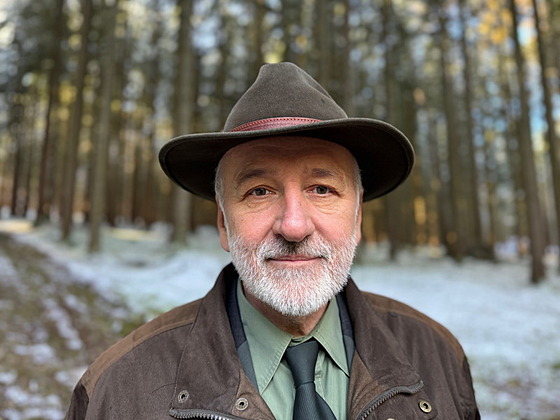Miloš Juha, Director of the Boubín Forestry Plant: bark beetle can be controlled
 When Miloš Juha joined the Boubín Forestry Plant, the annual harvest of bark beetle infested timber reached 213 thousand cubic metres. Thanks to preventive measures and modern technologies, the volume of bark beetle wood dropped by 95 %. When infested trees are detected in time, they can be harvested and sold at a standard price. The Boubín forestry plant is therefore one of the most profitable in the country and boasts healthy forests with natural regeneration exceeding 60 %. This is despite the fact that it is adjacent to the Šumava National Park, where bark beetle control is not actively pursued. How has this been done?
When Miloš Juha joined the Boubín Forestry Plant, the annual harvest of bark beetle infested timber reached 213 thousand cubic metres. Thanks to preventive measures and modern technologies, the volume of bark beetle wood dropped by 95 %. When infested trees are detected in time, they can be harvested and sold at a standard price. The Boubín forestry plant is therefore one of the most profitable in the country and boasts healthy forests with natural regeneration exceeding 60 %. This is despite the fact that it is adjacent to the Šumava National Park, where bark beetle control is not actively pursued. How has this been done?
In an interview, Director Miloš Juha describes how systematic monitoring and modern technologies such as bark cameraalso discusses the use of artificial intelligence and achieving a balance between logging and natural forest regeneration.
When it comes to the bark beetle calamity, they say, "What bark beetle? We have it under control." Really?
I say with exaggeration that the biggest "friend" of the bark beetle is the holiday. Bark beetle control is an ongoing task that requires daily care. Just a week's delay and control is lost. The greatest risk occurs during the growing season, which often clashes with the holidays - that's when bark beetles gain the upper hand. Success lies in continuous care of every tree, except in winter when bark beetle activity is minimal. This process is a lifelong task for the forester, bought about by careful and systematic work. However, this is how we really control the bark beetle.
And with almost 40,000 hectares of forest, can every single tree be cared for?
It is more of a metaphor, but systematic monitoring can identify bark beetle outbreaks and intervene effectively. We know when and where to focus - every time of the year has its priorities. We harvest infested trees in the early stages early, preventing the spread of bark beetle while maintaining the quality of the timber for standard sales.
How has this pedantic approach been reflected in the incidence of bark beetles?
Six years ago, the annual harvest of bark beetle-infested timber reached 213,000 cubic metres, which put a strain on both the forest and the plant's economy. After years of intensive work and the introduction of preventive measures, the volume has fallen by 95 %. This year, on almost 40 thousand hectares, we are recording only 8.5 thousand cubic metres of infested timber, which is a minimal amount compared to the surrounding owners. At the same time, we are adjacent to the Šumava National Park, where no action is taken against bark beetles, which increases the pressure on our forests. Nevertheless, our results are better. Without being adjacent to no-go zones, the infestation would be half as high.
This is a respectable result. How is such preventive monitoring implemented?
Fieldwork, data analysis and rapid response are essential. We need to find and harvest infested trees with still-green crowns before the wood becomes degraded. Although it may be perceived negatively by the public, felled "healthy-looking" trees tend to be in the early stages of infestation. The goal is to preserve the value of the wood and prevent the spread of bark beetles.
With such a vast expanse of forest, I don't see how it can be managed.
An elaborate system is in place. A specialist in Hradec Králové manages the bark beetle database, which is updated annually based on the course of the calamity. We monitor the swarming, plan actions according to the development of the bark beetle and regularly balance according to the growth and processing of infested trees. Foresters in the field mark and record infested trees so that they can be harvested quickly. The key is to catch infestations early.
Bark beetle mainly attacks trees over 60 years old, they have the highest economic value, right?
Yes, trees that are 60 years old and older are of the required dimensions and have the highest price on the market. Timely harvesting of infested trees is crucial - fresh wood can be worth three thousand crowns per cubic metre, while wood devalued by blueing drops to two thousand crowns per cubic metre. With our annual harvesting plan of over 300,000 cubic metres, late harvesting could mean losses of tens of millions of crowns.
Is that why you were one of the first to come up with the idea of a bark beetle camera?
The forest is complex and rugged, which makes monitoring difficult. Traces like crumbs are easily washed away by rain and then all that is left to find are small sink holes in the bark, which is challenging in the field. Bark camera was created for faster and more accurate identification of infested trees. It also responds to the unprofessional practice of cutting down more trees in private forests as a preventive measure. We, on the other hand, cut only clearly identified infested trees to minimize interference, protect forest stability and prevent unnecessary felling.
In what is bark camera so important?
The primary finding of bark beetles is crucial - distinguishing an infested tree from a healthy one. The camera allows detailed confirmation of sinkholes even in places where binoculars cannot be used, for example in stands with high dieback. It acts as an extended arm to enable accurate identification of the tree.
So, once you've identified a finding, it's time to process the data and evaluate the sites you're targeting. Similar to how a doctor analyzes x-rays and prior medical history?
Yes, we rely on the results of previous years. Forestry maps show us the age classes of stands - we focus on trees over 60 years old, where bark beetles can reproduce. We don't usually look at younger trees, except in calamity situations. The key is to monitor sites where bark beetle has been recorded before and focus on older stands. It is essential to catch an infestation early, while the tree has a green crown, and this can be done by bore holes, which are the main indicator of bark beetle. Once the tree starts to rust, it is too late.
So you're actually working as surgeons.
Accurate diagnosis allows us to focus on the problem areas and not waste time where it is not needed. Practical experience and ongoing training of foresters is key. I remember a case where we identified part of a forest as bark beetle infested - to the layman the forest looked healthy, but we knew that these trees could not be saved. Through timely treatment, we prevented the spread of bark beetle and at the same time sold the timber at full market price.
Could the use of drones help to locate bark beetle outbreaks?
The view from above is not reliable for early detection. Drones can identify trees with a distinct colour change, for example in summer when infested trees start to die. However, these changes come late, often after the bark beetle has broken through, and can also be caused by other factors such as fungi or tree stress. The key is to detect sinkholes early in the infestation, which is made possible by a bark beetle camera. This is lightweight, mobile and can be easily operated by a trained worker.
What kind of trees does bark beetle actually attack? They say it's quite selective.
Bark beetles target weakened trees, which benefits the health of the forest. But if it is allowed to overgrow, it will also attack healthy trees indiscriminately. At high population levels, it is no longer a matter of selection, but of destruction. During the great calamity in the national park, the bark beetle also attacked young trees, which was previously unimaginable. The overgrown bark beetle has thus lost its selectivity and started to destroy everything.
So bark beetles can indeed be controlled.
Yes, it is possible to control bark beetles while ensuring the prosperity of the forest. The key is prevention, which prevents excessive felling and subsequent reforestation of large areas. We need to keep the forest in balance with a high proportion of natural regeneration, which reduces the cost of caring for new growth.
Source: https://treeinsp.cz/

